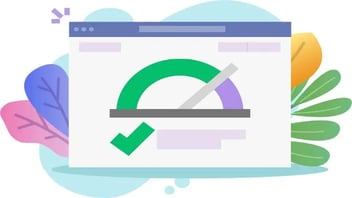What is Web Accessibility & Why Is It Important?
In today's digital landscape, inclusivity is paramount. Imagine navigating the web without seeing images or hearing audio – this is the challenge that web accessibility aims to overcome.
Let's uncover why web accessibility matters and how it shapes the future of the internet.

Understanding Web Accessibility
Web accessibility is the cornerstone of a digital landscape that values inclusivity and equal access. It involves designing and developing websites to ensure they can be used effectively by individuals with a wide range of disabilities. These disabilities encompass various challenges, including visual impairments, auditory limitations, cognitive differences, and motor impairments. The ultimate goal of web accessibility is to facilitate and improve UX for all visitors, eliminate barriers, allowing everyone to perceive, understand, navigate, and interact with online content seamlessly.
At its core, web accessibility is about recognizing that people experience the web in diverse ways.
-
Visual impairments might include blindness or low vision, requiring websites to offer alternative text for images and adaptable font sizes.
-
Auditory impairments, on the other hand, necessitate providing text captions or transcriptions for audio content.
-
Cognitive differences might involve difficulties processing complex information, thus requiring clear and concise content presentation.
-
Motor impairments can affect the ability to use a traditional mouse, prompting the need for keyboard navigation options and larger clickable areas.
Why Does Web Accessibility Matter?
1 in 4 adults in the United States has a disability. Yet, only 38% of websites are accessible to people with disabilities. Do you notice the disparity in these? Not only is this unfair to individuals with disabilities, but it's costing businesses in more ways than one. A lack of web accessibility costs businesses billions of dollars each year. One study found that a lack of web accessibility costs companies an average of $3.6 million annually.
Beyond the technical facets, web accessibility carries profound moral and ethical significance. Creating accessible websites means offering equal opportunities for everyone to access information and services, thereby fostering an inclusive society. Moreover, as many countries are instituting legislation mandating web accessibility, organizations must align with these legal requirements to prevent potential penalties and safeguard their reputation.
The Web Accessibility Initiative (WAI)
In web accessibility, one name stands out as a guiding light: the Web Accessibility Initiative (WAI). Spearheaded by the World Wide Web Consortium (W3C), WAI is pivotal in setting the standards and guidelines that shape the fabric of an inclusive online experience. This initiative underscores the commitment to making the web accessible to everyone, regardless of their abilities or disabilities.
Born out of the need to address the challenges faced by individuals with disabilities in navigating the digital landscape, WAI was established with a clear purpose – to develop guidelines that web designers, developers, and content creators can follow to ensure their websites are accessible to all. These guidelines, collectively known as the Web Content Accessibility Guidelines (WCAG), provide a comprehensive framework that aligns the diverse aspects of web accessibility, fostering a universal approach to digital design.
The cornerstone of WAI's influence lies in WCAG, a set of guidelines organized around four fundamental principles: Perceivable, Operable, Understandable, and Robust (POUR). Each principle delves into a specific aspect of web accessibility, guiding practitioners in crafting content and interfaces that cater to the needs of all users. Whether it's providing alternative text for images (Perceivable), ensuring keyboard navigation (Operable), simplifying content presentation (Understandable), or ensuring compatibility with evolving technologies (Robust), WCAG covers the entire spectrum of accessibility requirements.
WAI's influence extends beyond the realm of standards. It catalyzes awareness and education, urging businesses, governments, and individuals to recognize the importance of web accessibility. The initiative's commitment to collaboration ensures that expertise worldwide shapes these guidelines, resulting in a holistic and globally relevant approach.
The Importance of Web Accessibility
From its role in making websites usable for individuals with disabilities to its impact on legal compliance and search engine visibility, web accessibility is fundamental to creating an online space and holistic, Customer-Centric Experience that embraces diversity and equality.
Inclusivity and Equal Access
Web accessibility is a beacon of inclusivity, paving the way for equal access to digital content and services for everyone, regardless of their abilities. Just as physical spaces are required to be wheelchair-accessible, digital spaces should offer the same level of inclusiveness. Websites prioritizing accessibility become gateways for individuals with disabilities to engage fully with online information, products, and services, fostering a sense of belonging in the digital world.
Legal and Ethical Obligations
The importance of web accessibility extends beyond moral considerations – it's often a legal requirement. Many countries have enacted legislation mandating accessibility for public and private sector websites. Non-compliance can result in legal penalties and reputational damage. Embracing accessibility is not merely a matter of following the law; it reflects an organization's commitment to equity and social responsibility.
Expanding Audience Reach
Designing an accessible website goes hand in hand with expanding your audience reach. By ensuring that your content is accessible to individuals with disabilities, you tap into an untapped market segment. This translates to increased engagement, improved customer loyalty, and potential business growth. An accessible website caters not only to users with disabilities but also to their friends, family members, and supporters who appreciate and value inclusive practices.
Search Engine Optimization (SEO)
The intersection of web accessibility and SEO is a powerful one. Search engines prioritize user experience and relevance, and accessible websites inherently offer a better user experience for everyone. Elements such as straightforward navigation, descriptive headings, and well-structured content benefit all users, contributing to longer on-site durations, reduced bounce rates, and improved search engine rankings. A commitment to accessibility aligns with the core principles that search engines value.
Future-Proofing
In the rapidly evolving landscape of technology, web accessibility holds the key to future-proofing your online presence. As new devices, interfaces, and technologies emerge, an accessible foundation ensures that your content remains usable by a broad range of users. By designing with accessibility in mind, you preemptively address potential barriers that might arise with emerging technologies, saving time and resources in the long run.
Empowering an Inclusive Digital Future
Web accessibility is not just a feature or an afterthought – it's an essential element that shapes the digital world's future. The importance of web accessibility resonates in the foundation of inclusivity, ensuring that every individual, regardless of their abilities, can engage with digital content on an equal footing. This commitment extends beyond compliance with laws; it reflects an organization's values and dedication to creating an equitable society.
By embracing web accessibility, businesses expand their horizons, welcoming a broader audience that includes people with disabilities. The positive impact on audience reach, engagement, and loyalty cannot be overstated. Furthermore, the link between web accessibility and SEO presents a unique opportunity to improve user experience and search engine rankings.
As technology continues to evolve, websites designed with accessibility in mind will remain relevant and adaptable. The foresight to future-proof your online presence is an investment that pays dividends as you navigate the ever-changing digital landscape.
Stay tuned for the next installments in our web accessibility series, where we'll dive into the practical aspects of achieving web accessibility and explore essential web accessibility tools to make your website more inclusive.
This content is also available in:
- German: Was ist Web-Barrierefreiheit & warum ist sie wichtig?
- Spanish: ¿Qué es la accesibilidad web y por qué es importante?
- French: Accessibilité Web: en quoi ça consiste et pourquoi c'est important?
- Italian: Cos'è l'accessibilità del web e perché è importante?
- Romanian: Ce este accesibilitatea web și de ce este importantă?
- Chinese: 网页可访问性是什么?为什么它如此重要?








Leave a Comment